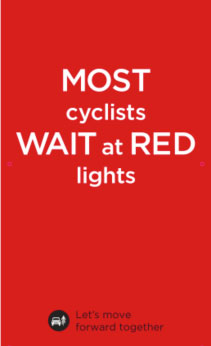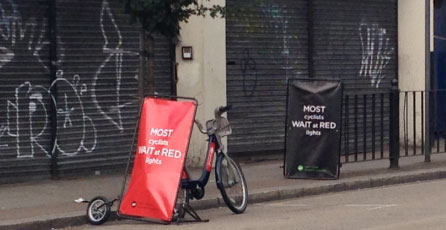 A simple behavioural intervention designed to reduce tension between cyclists and motorists in London resulted in a marked decrease in the number of cyclists jumping red lights at the junctions where it was trialled.
A simple behavioural intervention designed to reduce tension between cyclists and motorists in London resulted in a marked decrease in the number of cyclists jumping red lights at the junctions where it was trialled.
The intervention was created by The Behavioural Architects (TBA), a research and insight consultancy, in an attempt to tackle the ‘veritable war’ between cyclists and motorists on the capital’s streets.
TBA says the conflict is fuelled by motorists’ belief that most cyclists have no regard for the rules of the road. However, TBA suggests there is a considerable gap between motorists’ perceptions of the extent of bad cycling behaviour and actual bad cycling behaviour.
The consultancy references a 2013 YouGov study in which 69% of respondents in London said it is ‘common’ for cyclists to jump red lights. However, TBA points to other research which suggests only around 7-12% of London’s cyclists actually jump red lights.
After conducting qualitative research on the behaviour of both cyclists and motorists, and forming behavioural hypotheses on how to correct these, TBA designed a simple behavioural experiment at two high traffic junctions in London.
The experiment took the form of a series of small posters that communicated to motorists that only a minority of cyclists jump red lights.
The posters were deployed at two high traffic junctions in London, and TBA monitored the number of cyclists jumping red lights against a previous control (poster free) period, and the impact on motorists’ perceptions.
TBA says the intervention successfully decreased rush hour jumping behaviour by 21.4% and 14.5% respectively across the two junctions.

In a press release about the intervention TBA says: “These results reveal the potential power of a simple, inexpensive intervention based on insights from behavioural science. Our qualitative research further indicated the message challenged motorists’ existing inaccurate beliefs head on.
“Overall, the results of this pilot research suggest further explorations are worthwhile. If such a small study was able to promote some level of ‘Street Harmony’, a large-scale campaign may have the power to end motorist-cyclist tensions on the road altogether.”
14 October 2016
